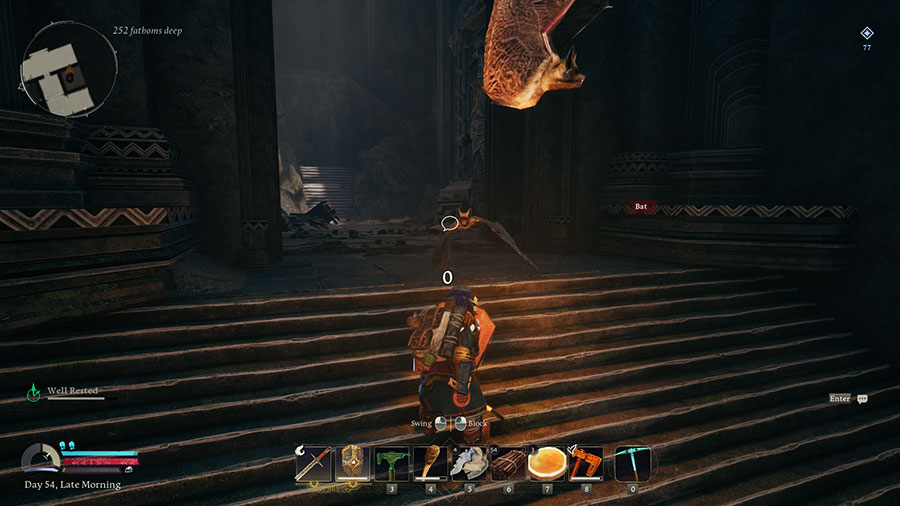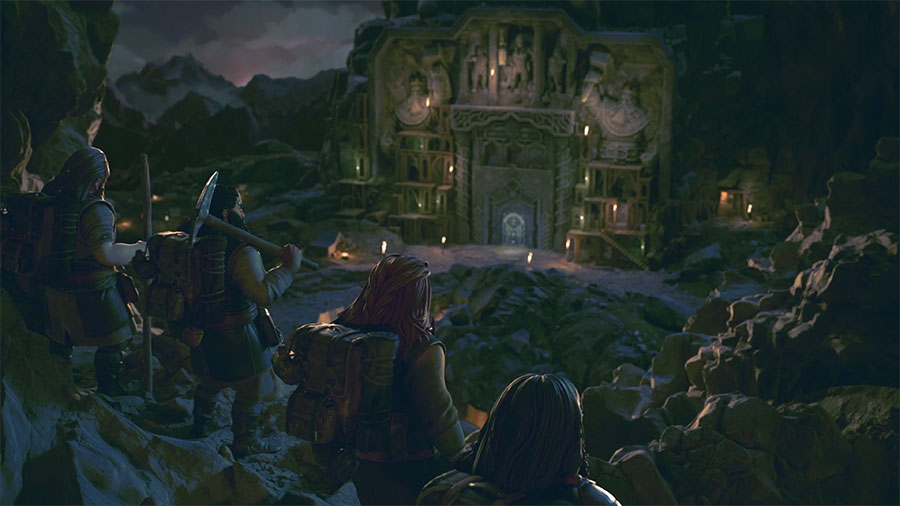The incredible writings of J. R. R. Tolkien are no stranger to the gaming industry. Battle for Middle-earth was a strategy epic, Lord of the Rings Online is one of the most impressive and long-standing MMO’s on the market, and Shadow of Mordor thrived on the war and conflict of its beloved setting. That said, there are still many corners of the Middle-earth we’ve yet to truly explore, many genres left untouched. Free Range Games and North Beach Games look to address at least two of those aspects, bringing the world of Lord of the Rings to a new genre and a new setting.
The Lord of the Rings Return to Moria follows the journey of a company of dwarves summoned to the Misty Mountains by Gimli as they hope to reclaim their home and restore honor to the dwarven people. Players will get to explore iconic locations from the movies, books, and beyond, all the while exploring a dark and gritty environment filled with peril and promise.
The Lord Of The Rings Return To Moria Review


Return to Moria doesn’t really look to bring anything new to the survival genre. Many of the features and mechanics are things we’ve seen time and time again, but it’s the Tolkien twist that really makes the game something special. Brewing beers and chanting with friends, swinging a pickaxe singing mining songs in unison, following the footsteps of the Fellowship as you dive deeper into the dark depths of the Misty Mountains. If nothing else, this is a game Tolkien fans will love.
Stumbling across iconic locations from the movies and books is exactly the same, every time. You hear a deep inhale as everyone in your party gasps in excitement as you discover Gandalf’s hat that was lost after the fight with the Balrog, food left behind by the hungry hobbits of the group, each and every one of these moments is inspiring, prompting chatter and sharing from everyone in the group. There are some truly epic moments that I don’t want to spoil but if you can push through some of the questionable survival design choices, there is awe and wonder to be found.

The Lord of the Rings Return to Moria is advertised as “the only survival crafting video game set in the Fourth Age of Middle-earth”, which although true, it occupies a niche within the survival genre that few games dare to tread. Heading into the darkened halls of Khazad-dûm and expecting an experience akin to ARK, Conan Exiles, any of the big names in the survival genre, is going to leave you frustrated and disappointed.
While the game shares a lot in common with the giants of the survival genre, it’s a more nomadic experience than most. Sure, you can build up a huge base and use it as a center of operations, but more than likely you’re going to construct a handful of bases at locations that have pre-existing facilities. You then use those as forward operating bases as you venture deeper and deeper into the depths. It’s not a bad design, far from it, but the traditional approach of survival games doesn’t really blend together with the progression-based exploration of the world itself.

Return to Moria is not about hunkering down building massive structures and hoarding endless resources. Almost the entire game is driven to focus on a single aspect, the journey. The challenges and adventures that await the dwarves as they look to reclaim their homeland. When you do stop to construct new base features or upgrade your weapons, it’s with the sole purpose of reaching the next tier of equipment so you can venture into the next area. It’s a finite experience, even with the procedural generation, which is a far cry from the near-endless gameplay loops typically offered in the survival genre.
Ultimately, I think it offers a more casual and accessible approach to the genre, giving players clear goals and objectives to follow every step of the way. Exploring and enjoying the core staples of the genre, crafting, survival, and gathering materials, all without needing to invest hundreds of hours over the course of a few months. However, this is unlikely to be what the average survival fan is looking for, so I’m expecting a mixed reception.

It feels closer to a narrative-driven experience borrowing from the survival genre, than a game with survival at the forefront of its design. However, what it does take from the survival genre, it takes with honesty and delivers with care. The crafting system, the backbone of both surviving and progression, is fantastic. You are constantly discovering new materials and recipes, expanding your bases functionality, discovering new ways to use valuable resources. It never feels overwhelming, you’re never expected to spend countless hours farming the same resources over and over, it’s a constantly moving and evolving system that is as rewarding as it is detailed. Construction, the art of building bases and large structures, not so much.
The game explains, through various tutorial and prompts, that structures require support and careful design. Pillars and bracers should be used to support and prop up larger structures, staying true to the legendary building prowess of the dwarven people. However, in practice, it doesn’t really work. I spent around 2-3 hours trying to build a larger base but I was unable to get even a single building to work. Endless pillars and supports, so many it would have made the building completely useless in a functional sense, and I still couldn’t get ceiling and walls to place with any structural integrity. Thankfully, the game is littered with the remnants of the dwarven civilization that once thrived here, so it’s much easier and faster to simply breath life back into these ruins and adopt those as a base.

Gathering, the art of spending ridiculous amounts of time doing menial labor tasks, is one of the core components of the survival genre but one thats importance is often overlooked. Return to Moria’s approach is infinitely better than the average competitor in the genre, delivering both ease of access and immersion in almost effortless fashion. Mining is incredibly satisfying, chipping away at rocks and ores as chunks disappear and reveal new materials. Think Age of Conan but with a little less realism. The real icing on the cake? Singing mining songs with your friends as you seek rarer and more valuable materials, singing in unison with each swing of the pickaxe. It’s such a basic concept but one that’s true to the source material and really makes something as boring as mining, surprisingly fun.
The combat system in Return to Moria is simplistic, and the lack of any real depth or meaningful progression does feel somewhat disappointing, but it still manages to deliver an incredibly rewarding and satisfying experience. There are very limited weapon types and each functions in the same manner. You have a quick, light attack, and a heavy attack that needs to be charged. You can block enemy blows with either a shield or your weapon, and with a shield equipped, you can push enemies to the floor. The combat you experience in the first few minutes of the game is nearly identical to the combat in the final moments but despite the lack of depth, I still really enjoyed it.

You can block indefinitely, there are no stamina or other restrictions. Enemy attacks are easy to scout and predict. This allows you to survive almost any encounter if you have the skill and patience to block, dodge, and counter at the opportune moment. The lack of enemy variety, a handful of different orcs, some spiders, trolls, few unique creatures, leans further on the one-dimensional combat system, and it’s either going to make you love it more or hate it entirely.
Weapons and equipment come in different tiers and each enemy you encounter will be resistant to lower-tiered weapons. The progression loop is identical throughout as you reach new locations and find new resources, you craft higher-tier weapons that do more damage to higher-level enemies. Early on this feels rewarding but as you unlock the higher-tier weapons the lack of meaningful change does start to feel underwhelming, making the latter stages of progression in the game the most disappointing.
And this is where the game struggles the most. The progression is often set at a different pace to your exploring efforts. There are 4 main regions in the game, The Western Halls, The Lower Deeps, Dwarrowdelf, and Barazinbar – all of which we explored fully with the exception of the final area. Each a combination of procedurally generated rooms and jaw-dropping set pieces created by developers with a clear love and passion for the universe. Each area is inhabited by stronger creatures and orcs than the last, and with the materials to upgrade your equipment to suit.

The trouble is, you are often reaching these locations and exploring them long before you have the required equipment to engage the enemies. In the Lower Deeps we explored every cavern, every orc camp and town, and were left short of a vital resource required to progress. Then in Dwarrowdelf, an area almost entirely consisting of stone structures and buildings, we struggled for hours to find Ironwood, chopping down and destroying every wooden structure we could find. Ultimately, this is what prevented us exploring further. In a game that is so heavily focused on progression, exploration, always moving forward, these hard-stop resource blockers just left a sour taste.
We did reach out to the developers to learn if this was a bug or an error but never heard back and sadly, it’s not the only bug skulking away in the dark corners of the mines. Fast travel points with infinite loading, others that didn’t work at all, graves of players (and all their loot) disappearing from the UI, a UI so cluttered with icons and objectives that it was nearly impossible to explore in certain directions (you’re meant to be able to turn these off), enemies spawning within the walls of your base or inches from your face. The entire map being ridden of all enemies, including important boss fights, breaking a number of quests. It’s a game that feels as though it enjoyed a few months polish under Early Access but still isn’t quite ready for release.

I really enjoyed my time in The Lord Of The Rings Return To Moria, despite its numerous issues. It’s a heartwarming gesture of passion and dedication to the works of J. R. R. Tolkien. Gathering around the Meal Table and sharing breakfast with friends before venturing out to explore. Encountering the remnants of the iconic journey of the Fellowship. Everything Lord of the Rings about this game has been done perfectly, it’s just a shame other areas of the game did not get the same level of love and attention.
I’m going to hold out on giving the game a final score until we’ve seen a few patches. In its current state, the earlier levels are perfectly playable but as you get further in to Khazad-dûm, the experience is poor.
The survival genre is already a niche of its own and the Return to Moria experience carves out an even smaller corner for its own existence, chipping away at the genre norms and forging its own path. Fans of Tolkien’s creation are sure to fall in love with the level of passion and detail given to the lore and environments but traditional survival fans may find the combat and linear nature of the game to be somewhat disappointing.
This review of The Lord of the Rings Return to Moria was done on the PC. A digital code was provided.
The incredible writings of J. R. R. Tolkien are no stranger to the gaming industry. Battle for Middle-earth was a strategy epic, Lord of the Rings Online is one of the most impressive and long-standing MMO’s on the market, and Shadow of Mordor thrived on the war and conflict of its beloved setting. That said, there are still many corners of the Middle-earth we’ve yet to truly explore, many genres left untouched.
Muse Games and Kwalee’s Wildmender is a survival game about restoring the land for resources rather than destroying it. The concept sounds intriguing, but how does it perform in practice? Check out our review and find out.
After many years of waiting, Turn 10 and Xbox Game Studios’ Forza Motorsport finally launches in a year without Forza Horizon. Is the racing game good enough to be worth playing, or should you spend your time somewhere else?
Ubisoft’s latest installment in the Assassin’s Creed franchise sees a return to its roots, its stealth foundations that led the way for one of the most recognizable franchises of today. Returning to the Middle East to revive the near-forgotten origins of the franchise is almost poetic but such a drastic change in direction seldom goes well.
- SEO Powered Content & PR Distribution. Get Amplified Today.
- PlatoData.Network Vertical Generative Ai. Empower Yourself. Access Here.
- PlatoAiStream. Web3 Intelligence. Knowledge Amplified. Access Here.
- PlatoESG. Carbon, CleanTech, Energy, Environment, Solar, Waste Management. Access Here.
- PlatoHealth. Biotech and Clinical Trials Intelligence. Access Here.
- Source: https://www.gamersheroes.com/honest-game-reviews/the-lord-of-the-rings-return-to-moria-review-in-progress/








